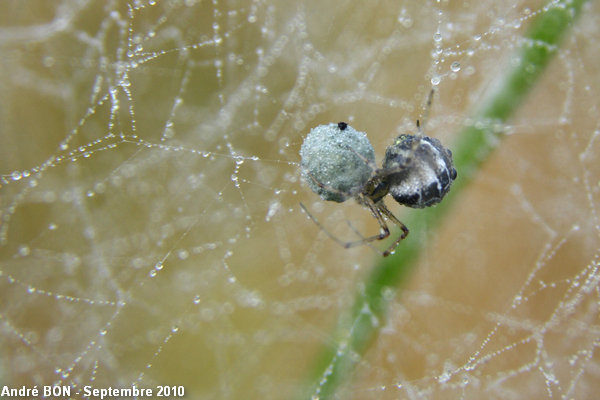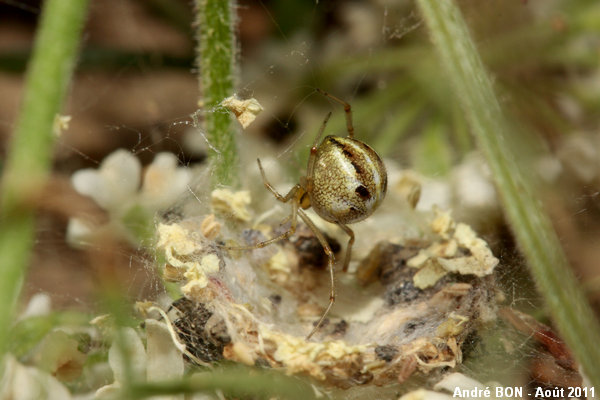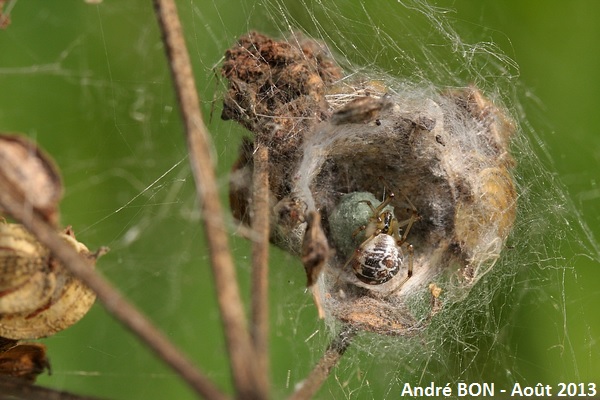



| Phylloneta of the impressa group (Phylloneta impressa-sisyphia (L. Koch, 1881 - Clerck, 1757)) |




|
|
Scientific name: Phylloneta impressa-sisyphia (L. Koch, 1881 - Clerck, 1757) Common name: Phylloneta of the impressa group Other names: Old scientific names: Theridion impressum - Theridion sisyphium. French name: Phylloneta du groupe impressa Order: Araneae Family: Theridiidae Size: 2.5 to 5.5 mm. Biotope: Woodland edges, shrubs and bushes for Phylloneta sisyphia. Meadows on Gorse, Thistles and high grasses but also on shrubs and bushes for Phylloneta impressa. Web: Three dimensional tangle web made up with a mess of horizontal and vertical threads. The central area is sticky and is used to capture small insects. This spider builds a cup-shaped retreat, next to the upper side of the web, with small pieces of plants. The opening of the retreat is on the under side. Observation period: Females are observed from May to December. Males are observed from May to August. Geographic area: Palearctic region for Phylloneta sisyphia, Europe, North Africa, northern Asia. Holarctic region for Phylloneta impressa, that's to say plus North America. |
The spiders of the Theridiidae family show a globulous abdomen with very thin legs. You cannot differentiate Phylloneta sisyphia from Phylloneta impressa on photo. They show a yellowish brown or reddish brown cephalothorax with a broad black median stripe and a black margin. The abdomen is yellowish or reddish and often shows a light-coloured central band, between two darker bands. These dark bands are divided into several parts by thin oblique white lines. This pattern, which looks like the veins of a leaf, is the origin of the genus name (from phyllos, leaf in Greek language). The legs are pale brown and ringed on the joints. Females carry their bluish ball-shaped egg sac around with them. They feed the young spiders on regurgitated food and then by directly bringing the preys to them. If they die before the young leave the nest, they will eat their body. There is sometimes a possible confusion with Theridion varians. This last one has yellowish legs ringed with grey. |
| [To know more about the Phylloneta of the impressa group] [Next picture] [Top] |

|
I came to the edge of the forest of Rambouillet, on this September day, hoping to ear Red Deers belling. Unfortunately I have underestimated the time needed to drive there and I arrived too late after sunrise. However, I have done a nice walk and I have been able to admire many webs covered with dew. The identification of Phylloneta of the impressa group is here based on the shape of the web, on the blue egg sac and on the markings you can see on the abdomen. |
| [To know more about the Phylloneta of the impressa group] [Next picture] [Previous picture] [Top] |

|
I have bent one umbellifer to observe this spider inside its small nest. This one is relatively pale coloured. I have read that this may be caused by its inflated abdomen, stretching the black marks, before laying the eggs and making its blue egg sac. |
| [To know more about the Phylloneta of the impressa group] [Next picture] [Previous picture] [Top] |

|
You can better see the dark markings separated by thin white lines on this picture. |
| [To know more about the Phylloneta of the impressa group] [Previous picture] [Top] |

|
Here is one observation done two years after at about the same place. The eggs are laid and the blue green egg sac is made. |